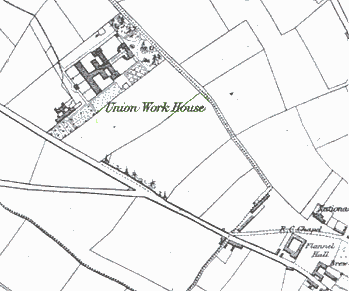Rathdrum, Co. Wicklow
Rathdrum Poor Law Union was formally declared on the 25th September 1839 and covered an area of 324 square miles. Its operation was overseen by an elected Board of Guardians, 30 in number, representing its 12 electoral divisions as listed below (figures in brackets indicate numbers of Guardians if more than one):
Co. Wicklow: Arklow (4), Aughrim (2), Castlemacadam (2), Dunganstown (2), Glendalough (2), Glenealy (2), Kilbride (2), Killiskey (2), Newcastle (4), Rathdrum (4), Roundwood (2), Wicklow (2).
The Board also included 10 ex-officio Guardians, making a total of 40. The Guardians met each week on Monday.
The population falling within the Union at the 1831 census had been 51,689 with divisions ranging in size from Killiskey (population 2,025) to Arklow (8,325), Newcastle (7,521) and Rathdrum itself (6,868).
The new Rathdrum Union workhouse was erected in 1840-1 on a 5.5-acre site a mile to the north-west of Rathdrum. Designed by the Poor Law Commissioners' architect George Wilkinson, the building was based on one of his standard plans to accommodate 600 inmates. Its construction cost £6,600 plus £1,200 for fittings etc. The workhouse was declared fit for the reception of paupers on 21st December 1841, and received its first admissions on 8th March 1842. The site location and layout are shown on the OS map from the early 1900s.

Rathdrum workhouse site, 1900.
The main buildings followed Wilkinson's standard layout. An entrance and administrative block faced the road at the north-east of the site. Behind, the main accommodation block contained the Master's quarters at the centre, with male and female wings to each side. At the rear, utility rooms such as bakehouse and washhouse were connected through to the infirmary via a central spine containing the chapel and dining-hall.
During the famine in the mid-1840s, accommodation was provided for an additional 200 inmates in the nearby Flannel Hall, courtesy of Earl Fitzwilliam. A house was hired as a fever hospital for 60 patients. A fever hospital was later erected at the south-west of the workhouse.
The former workhouse buildings are understood to have been demolished in 1970.
Records
Note: many repositories impose a closure period of up to 100 years for records identifying individuals. Before travelling a long distance, always check that the records you want to consult will be available.
- Wicklow Family History Centre, County Council Buildings, Station Road, Wicklow Town, Co. Wicklow.
Bibliography
Links
- None.
Unless otherwise indicated, this page () is copyright Peter Higginbotham. Contents may not be reproduced without permission.


